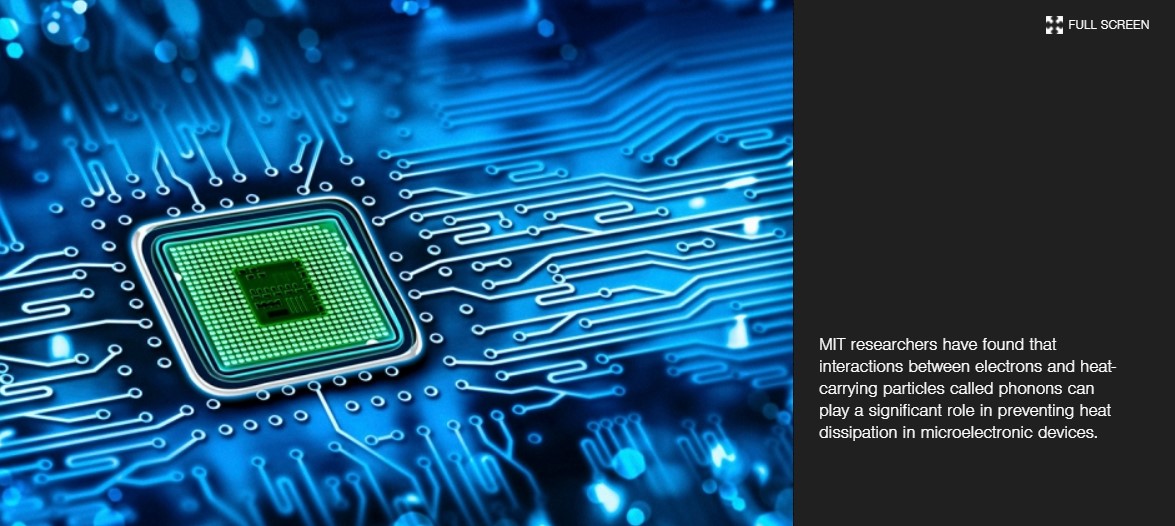
In the coming years, as more transistors are stuffed into ever littler zones inside PC chips, MIT engineers say cellphones, tablets, and other electronic gadgets may confront a higher danger of overheating, because of connections amongst electrons and warmth conveying particles called phonons.
The analysts have discovered that these beforehand thought little of collaborations can assume a noteworthy part in counteracting heat scattering in microelectronic gadgets. Their outcomes are distributed today in the diary Nature Communications.
In their tests, the group utilized exactly planned laser heartbeats to quantify the associations amongst electrons and phonons in a thin silicon wafer. As the grouping of electrons in the silicon expanded, the more these electrons scattered phonons and kept them from diverting warmth.
"At the point when your PC is running, it creates warmth, and you need this warmth to scatter, to be completed by phonons," says lead creator Bolin Liao, a previous graduate understudy in mechanical designing at MIT. "In the event that phonons are scattered by electrons, they're not in the same class as we thought they were in doing heat. This will make an issue that we need to explain as chips wind up plainly littler."
Then again, Liao says this same impact may profit thermoelectric generators, which change over warmth straightforwardly into electrical vitality. In such gadgets, dispersing phonons, and in this way diminishing warmth spillage, would altogether enhance their execution.
"Presently we know this impact can be huge when the centralization of electrons is high," Liao says. "We now need to consider how to build the electron-phonon cooperation in more modern approaches to profit both thermoelectric and microelectronic gadgets."
Liao's co-creators incorporate Gang Chen, the Carl Richard Soderberg Professor in Power Engineering and the leader of the Department of Mechanical Engineering; Alexei Maznev, a senior research researcher in the Department of Chemistry; and Keith Nelson, the Haslam and Dewey Professor of Chemistry.
Blocking stream
In transistors produced using semiconductor materials, for example, silicon, and electrical links produced using metals, electrons are the fundamental specialists in charge of leading power through a material. A primary motivation behind why such materials have a limited electrical protection is the presence of specific detours to electrons' stream — specifically, collaborations with the warmth conveying phonons, which can slam into electrons, diverting them from their power leading ways.
Researchers have since quite a while ago concentrated the impact of such electron-phonon associations on electrons themselves, however how these same communications influence phonons — and a material's capacity to lead warm — is less surely knew.
"Individuals barely contemplated the impact on phonons on the grounds that they used to think this impact was not essential," Liao says. "Yet, as we probably am aware from Newton's third law, each activity has a response. We simply didn't know under what conditions this impact can end up plainly noteworthy."
Scramble and rot
Liao and his partners had beforehand ascertained that in silicon, the most normally utilized semiconductor material, when the convergence of electrons is over 1019 for every cubic centimeter, the connections amongst electrons and phonons would unequivocally disseminate phonons. What's more, they would decrease the material's capacity to disperse warm by as much as 50 percent when the focus achieves 1021 for each cubic centimeter.
"That is a truly noteworthy impact, however individuals were incredulous," Liao says. That is fundamentally on the grounds that in past analyses on materials with high electron focuses they accepted the diminishment of warmth scattering was expected not to electron-phonon collaboration but rather to deserts in materials. Such deformities emerge from the way toward "doping," in which extra components, for example, phosphorous and boron are added to silicon to expand its electron focus.
"So the test to check our thought was, we needed to isolate the commitments from electrons and deformities by some way or another controlling the electron fixation inside the material, without presenting any imperfections," Liao says.
The group built up a procedure called three-beat photoacoustic spectroscopy to correctly expand the quantity of electrons in a thin wafer of silicon by optical strategies, and measure any impact on the material's phonons. The system develops a traditional two-beat photoacoustic spectroscopy method, in which researchers sparkle two accurately tuned and coordinated lasers on a material. The main laser produces a phonon beat in the material, while the second measures the action of the phonon beat as it dissipates, or rots.
Liao included a third laser, which when shone on silicon definitely expanded the material's centralization of electrons, without making absconds. When he gauged the phonon beat in the wake of presenting the third laser, he found that it rotted considerably speedier, showing that the expanded grouping of electrons acted to disseminate phonons and hose their action.
"Happily, we found the exploratory outcome concurs exceptionally well with our past estimation, and we would now be able to state this impact can be really huge and we demonstrated it in tests," Liao says. "This is among the principal trials to specifically test electron-phonon cooperations' impact on phonons."
Curiously, the scientists initially began seeing this impact in silicon that was stacked with 1019 electrons for every cubic centimeter — similar or even lower in fixation than some present transistors.
"From our investigation, we demonstrate this will be a truly significant issue when the size of circuits ends up noticeably littler," Liao says. "Indeed, even now, with transistor estimate being a couple of nanometers, I figure this impact will begin to show up, and we truly need to truly consider this impact and consider how to utilize or maintain a strategic distance from it in genuine gadgets."
This exploration was upheld by S3TEC, an Energy Frontier Research Center financed by the U.S. Branch of Energy's Office of Basic Energy Sciences.
Original Post: http://news.mit.edu/2016/electron-phonon-interactions-affect-heat-dissipation-computer-chips-1012
 hiveblocks
hiveblocks